
Course success depends a lot on how you map out marketing strategies for online courses. You have spent many hours, even months building your course. You have done a tremendous amount of work on your course and now is the time to reap the benefits. But to do this, you need to attract more buyers and increase sales by doing effective marketing of your course.
If you have read our article, you know that courses do not usually provide recurring revenue like memberships, so the struggle for attracting new buyers is continuous. Do not worry, our following marketing strategies for online courses will make your life a lot much easier. Let’s dig into these practical steps to grow your course sales.
Table of Contents
Toggle- Marketing Tips Before Building Course
- 1. Define Target Market
- 2. Survey Audience and Test your Course Idea
- 3. Identify Value Proposition
- 4. Keyword Research
- 5. Build an Email List
- Marketing Tips after Building Course
- 1. Promote your Course by Blogging
- 2. Promote it on Social Media
- 3. Email marketing
- 4. Google ads
- 5. Start a Podcast
- 6. Webinars
- 7. Contribute to other Blogs and Resources
- 8. Local events and meetups
- 9. Tiered courses and mini-courses
- 10. Discounts, coupons etc.
- 11. Time limit
- 12. Offer an Installment Payment Plan:
- 13. Money-back guarantee
- 14. Offer support
- Conclusion:
Marketing Tips Before Building Course

Most successful course makers start thinking about their market demand and advertising strategies even before starting building the course. It helps to understand whether your course topic and content are actually in demand and what will be its estimated sale value. If you are at the planning stage, here are a few steps to undergo before finishing off the course.
1. Define Target Market
Every marketer lives through this principle. Knowing your target market is as important as building a product. If you have finished off the product, whom are you going to sell it to? Figure out your target audience and their needs wants desires and fears. What do they want from your course? How will you reach out to those people, who will be interested to buy your course?
Some like Thinkific and Jim Edwards, author of Copywriting Secrets, even suggest defining an avatar of your perfect customer. Take some time and write down his personality, his needs, desires, fears, likes and dislikes. It helps to build that relationship with your target market and you know all the points where to pitch your product.
2. Survey Audience and Test your Course Idea
If you have already published a blog or social media page and have an audience, pre-test your course by asking them. You can either send them a survey, asking them the topics in which they will be most interested. Including your audience in the course, creation helps to validate the course demand.
However, if you do not have an audience try doing some online surveys like Survey Monkey or do deep research on Google and figure out what are the most common problems and issues, faced by people in your targeted market.
3. Identify Value Proposition
A very famous saying is, “People buy benefits, not the product.” This is absolutely true in the real world. You can procrastinate about the features of your course, but people are most interested in the value your course will be offering. They want practical benefits from the course, which can help them solve a current issue or achieve a certain goal.
For example, if your course is also available in the form of a mobile app, it’s a feature. But, its benefit is that the reader can access it anytime, anywhere, whether during travel or sitting on a lounge sofa.
At this point, you can do some competitor research just to understand what they are offering. What are the most desired benefits of their courses and how you can differentiate them from them? Maybe you are thinking of providing support along with the course material which is a very good offering. So, identify your value proposition and sell it rather than the features.
4. Keyword Research
If you have an already published blog, you might be familiar with the power of keywords in Search Engine Optimization. If not, let’s see how it works. Just assume that you are thinking of a specific problem and search for it on Google.
For example, if you are worried about designing your course page so you will type in Google’s search bar “How to design a course page” and voila!! You have a list of many website pages and links to choose from ranging from page 1 to many more.
You will choose from the top 5 or 10, maybe without even bothering to go on page 2 of google searches, because you are thinking these are the most researched and most credible sources of information.
This is the power of SEO as it helps to bring your webpage, blog post, article, video link etc. to the top Google searches. You can go to Google and search for your specific course topic and see its related searches. You can also go to Keyword Planner or LSI Graph, to search for the most relevant keywords and include them in your course content.
5. Build an Email List
Building an email list before launching the course not only helps to improve sales but also helps to do test marketing and pre-sell your course. It helps to engage readers long before you have launched your product. That is why it is one of our most favourite marketing strategies for online courses.
You can do this by building your course website and offering a freebie (something valuable) in exchange for the email address if someone subscribes to your mailing list. You can promote it on your social media channels as well.
Marketing Tips after Building Course
You have completed working on your course and did not think of doing any marketing before finishing it. We have got you covered. Our following tips will help you increase your sales even if you have not done any advertising before.
1. Promote your Course by Blogging
Blogs are a great way to promote your course. If you blog on the same topic as your course, it’s a great way to market your course. Providing free content and guides in the blogs. also help to define you as a trustworthy authority in your field, who has enough knowledge and expertise.
This credibility helps to boost the sales as people know they will not be wasting their time and money on some fruitless course without any outcomes. It is one of the most effective marketing strategies for online courses.
Blogs also bring in traffic which makes it easier to make the people aware of your course. It is your own platform and you can market your product the way you want. People who are already reading your blogs are interested in listening to you and it helps to build a connection with the audience.
Also, blogs are a great way to build a mailing list and sell your course by email marketing. You can also direct your blog traffic to your social media pages and promote your course on social media as well.
2. Promote it on Social Media
We hear it very often that “Now is the era of social media marketing.” According to Statista Research Department, 91.9 percent of U.S. marketers in companies largest than 100 employees were expected to use social media for marketing purposes in 2021.
Facebook, Instagram and Twitter, are not only recreational tools but they are very strong marketing platforms due to their reach. Facebook has about 2 billion active users and offering your product to such a big market does sound astonishing. This is why your marketing strategies for online courses must include promoting your course on social media.
Similarly, many people build their YouTube channels before the course launch and offer valuable information along with pitching their course. You can also use paid Facebook ads to reach out to a more targeted market and sell your course.
3. Email marketing

Email marketing is very targeted marketing and it helps to build a personal connection with the client. Some people think that email marketing is long dead, however, it’s not true. If done correctly, it can not only increase your current sales but also provide you long term, engaged customers as well.
Only those who are actually interested in your content provide you with their email addresses to hear from you in the future, they are more likely to make a sale than offering your product to thousands of uninterested audiences. Read our article on improving email marketing results for more information.
4. Google ads
If you have the budget, you can also use Google ads to publicize the course. It will advertise your course when people search for the related keywords. If you know your target market and how they will be searching for a piece of relevant information, Google ads can help you to make your course known to your targeted audience and increase its visibility on other websites which run paid google ads.
5. Start a Podcast
Podcasts are a great way to boost your course sales. It also improves your content and provides valuable information and tips to your listeners as well as market your product.
You can start your own podcast where you can talk about the issues which your listeners might be experiencing and provide tips and strategies to overcome them. In the end, you can add in a call to action, by pitching out your course.
You can also invite guests or become a guest to other people’s podcasts. Publishing your podcast on iTunes or Google Play can help you reach out to thousands of people. Search for the podcasts relevant to your course topic and listen to their episodes to understand how they are building their content.
You can also send their hosts’ personalized emails to invite you to their show. Provide worthy insights rather than just selling out your product. In the end, you can give your contact for more information about your courses as well.
6. Webinars
Webinars also help to keep in touch with the target audience. It works just like a podcast but with a video as well. You can also go live with a Q&A session, where you directly provide replies to the audience’s queries. You provide free content and advice to the people and at the end, you can tell them about your course as well.
You can also bring in other people from your industry to talk about major problems or even their success stories. They can be your exact competitors or the people who have used your strategies to achieve their goals or even those who are not your direct competitors but work in the same field.
In this way, you can engage the audience by providing them amazing content absolutely free while enhancing your potential customer base.
7. Contribute to other Blogs and Resources
There are many established websites, magazines and blogs in need of regular, quality content. You can find such platforms and write for them as a guest writer. It helps you to get exposed to hundreds and thousands of other people which are not your audience and make them your customers as well.
You can tell them about your courses, books or any other material in your about the author’s portfolio. If your content is good enough to engage the visitors, you might get a spot for a regular guest column on an established platform. They get quality content and you get exposed to millions of people for free. It’s a win-win situation for all.
An easy way to find websites which offer guest posts write keywords relevant to your course topic which you think your targeted audience will be searching for and add (write for us) at the end. For example, if you think your target audience is interested in “house decoration”, type House Decoration (write-for-us).
8. Local events and meetups
You can go to local events and meetups to build contacts with like-minded people. You can also ask the arranger to allow you to talk about a specific topic related to your course. If they allow you to sell your product, you can also pitch it at the end of the talk.
You can also start your own Meetup group but it requires a lot of effort. You can invite guest speakers and give presentations yourself. It helps to build you as an authority in your industry.
9. Tiered courses and mini-courses
A mini-course is a small but comprehensive segment of your whole course that you can either sell separately or offer as e freebie to your audience. For example, if your course is designed to build, run and market a membership website, you can take out the building section and offer it as a mini-course.
Tiered courses mean you create multiple levels of a course and multiple prices. For example, if you are offering a course at $500, offer its version with added support and premium experience at $1000 as well.
It brings variety to your offering. If a person needs premium support, he can go for a more expensive option. These added services and options are a great way to attract a wider audience and enhance your course portfolio.
10. Discounts, coupons etc.
According to eCommerce Suggest, 54% of people buy retargeted products when offered at a discounted price. The same thing is done by all the brands and retailers when offering the same products with 25% or 50% discounts. Offering a first buyer discount or discount coupons on Cyber Monday, Thanksgiving and other sales can also boost your course sales.
11. Time limit
Offering specific enrollment periods help to attract more students as they create a sense of urgency. Many people procrastinate and if they are not exposed to a time limit, they will not take any action. When they are interested in the course and know that the course sale is going to end soon, they are more likely to purchase it. On top of that, you can offer the last hour or last day discount to burn the desire.
It also gives another benefit. If you are offering extra support or service, it is better to have a one time larger class than 1 or 2 students at one time. It becomes easier to navigate their progress and provide assistance. Moreover, the students can themselves make peer contacts and get peer support as well.
12. Offer an Installment Payment Plan:
If you are offering a premium course of $1000, the person who does not have upfront money can not buy it. So, you can divide the cost into five $200 instalments. It will bring in more people by widening the price selection as well. If you are interested in recurring income, this strategy will offer you recurring revenue as well rather than a huge upfront price.
Remember to divide the whole price into smaller sections, affordable to the people. If you divide a $2000 price into two instalments of $1000, it’s not very practical because a person who is not willing to pay $2000 upfront, is not likely to pay $1000 as well. So, offer smaller instalments which are more affordable and convenient for your buyers.
13. Money-back guarantee
Offering a money-back guarantee can increase the course sales as it deals with the fears of buyers that they might lose their money once the course is purchased.
It also builds trust with the buyers because no one will offer a money-back guarantee unless he is quite confident about the course content and the value proposition. Most course creators offer a 30-day money-back guarantee so that if a person is not satisfied in 30 days, all of his money will be returned.
14. Offer support
Many students want to get support in implementing their knowledge into practical life. They want to get in touch with their course mentors as well. Not all the course creators provide support to their students and if you do this, your sales can be skyrocketed.
You can make a specific discussion forum or a private Facebook group to discuss things with the students. It will also help to build a community and gain the trust of the students and you can offer your premium course or next course to them and they will be gladly buying it keeping in mind your service and support.
Follow up emails are also a great way to keep in touch with the students. When someone purchases a course, send him/her a welcome email and details about how to log in and do the stuff. Many people start losing focus after 2-3 weeks.
So, you can send a follow-up email to remind them of their goals and objectives and relax them by mentioning that they still have a lot of time to catch up. Rather than pitching more and more products after one sale, try to keep that sale as well to avoid a refund.

Conclusion:
We are sure that these tips will help you to amplify your course sales. Do not worry about so many options and strategies. It just takes a good amount of planning to create a comprehensive sales strategy.
For example, when you do a webinar or a podcast, you can divide the whole session into small bits of informative videos and send them separately as a freebie in your emails or share them on your social media platforms or make your ad content with them.
Similarly, you can transcribe the video and publish it as a blog or you can also publish your webinar video on your YouTube channel. You can get a huge value from a single video and much more if you strategize properly. Keep growing.








